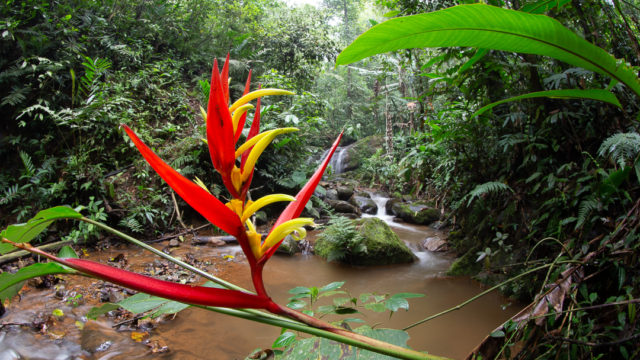Colour, energy, succulent food and sultry heat, these are all the ingredients for a love affair in the tropics.
The two partners are passionate about one another. They need one another, they cannot live without each other and each are dressed in costumes that sparkle – like all great celebrities do.
These celebrities are firstly, the energetic, dazzling hummingbirds of the New World, who move about the tropical forest like high speed racers.

Secondly there are the architecturally shaped, exotic, Heliconia plants. They hide away amid the dark green foliage, but are clothed in an orange or red mantle that would outshine a queen.

The hummingbirds seach for the plants and the heliconias wait for the birds.
When we walk through tropical forests there is often a sense of foreboding. The darkness and damp humidity surround us as we stumble over storm thrown trees. Occasionally amidst the dim verdant luxuriance we can see splashes of bright enticing colours.

These are the Heliconias and they brighten up the forest as nothing else quite does. In fact Heliconias are so named after the greek Mount Helicon, the home of the muses. The muses were the goddesses of literature, science, art and music, all the aspects of life that are bright and beautiful, most worthy and sought after.
Heliconias and Hummingbirds are partners that evolution has crafted for millions of years. Heliconia plants have designed their weird and wonderful shapes to attract different species of Hummingbirds.
A Green Hermit Hummingbird, its wings beating at 50 beats a second, holds itself steady whilst it bends its head sideways and manoeuvres its bill into a tiny tubular flower.

Deep within their colourful outer shells, the plants hide tiny insignificant flowers rich in nectar. Hummingbirds have tongues twice as long as their bills and it is this as well as their ability to hover in flight which enables them to extract the nectar.
A Violet-tailed Sylph extracting nectar to nourish its high speed lifestyle.

In so doing the flowers deposit pollen on the bird’s head and when the bird visits the next flower, pollination is complete. A love affair in the tropics that benefits the whole forest.
